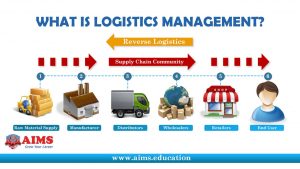Why Logistics Management Inventory is Useful
Logistics management plays a key role in any company that orders materials or ships products. It’s a critical component of the supply chain. Understanding how it works as well as why it’s important can significantly impact a company’s bottom line.

Logistics Management Inventory
What is Logistics Management?
Logistics management is part of supply chain management. It helps companies store and move items from one location to another. Logistics management can be used when suppliers send materials to companies or when businesses ship products to customers.
Five Aspects of Logistics Management
The five aspects of logistics management are storage, shipping, tracking, network design and planning. Fine-tuning each of these components ensures that you move inventory efficiently throughout your supply chain, saving time and money.
1. Storage
Companies can choose to store raw materials, inventory, or finished products in their own warehouse, or with a third-party. Many 3PL businesses exist today, handling a significant portion of logistics management for many customers. Since warehousing is their core business, 3PL providers can often offer these services at a lower cost.
2. Shipping
The movement of items, materials, or products between different locations can be a challenging component of logistics management. Incoming materials and inventory must be tracked. In addition, finished products might be sent to a warehouse, distribution center, retail store, or directly to customers.
3. Tracking
With so many items and orders traveling to different locations, tracking material is critical. By employing technology such as barcoding or RFID, you can more efficiently locate both raw materials and products at any moment. Effective tracking means faster service, lesser downtime, and reduced costs.
4. Network Design
The engineering of the actual network can make a big difference in logistics management efficiency. Shipping from a closer physical location, as well as understanding shipping availability and transportation costs, can cut days from the delivery schedule.
5. Planning
If your business experiences seasonal peaks and valleys, you may rely on logistics management to help manage these fluctuations. Where and when you’re shipping your products, as well as the capacity of both storage and transportation options may be affected significantly by this change in demand.
Supply chain logistics is the management of all the companies, transportation, warehouses, and distributors needed to deliver a final product. In our global economy, that may involve dozens of businesses that must play a part to procure or produce raw materials, parts, and services to get an item into the hands of a consumer.
What is supply chain logistics?
Challenges
Managing supply chain logistics can get complicated quickly. Businesses must determine the right balance between being nimble enough to be competitive while minimizing the potential costs of tools and technology required to achieve that flexibility.
As a result, many executives simply do not have the visibility they require to make the best business decisions for their company. This can lead to poor customer service, increased production downtime, and stressed supplier relationships.
Solutions
Better supply chain logistics often comes down to automated, efficient warehouse and inventory management. Although one company cannot manage the inventories of supplier companies, it can do a better job of tracking its own inventory from the point of ordering and arrival and throughout its production system.
Barcoding technology and RFID tags can improve the efficiency, accuracy, and speed of managing how inventory moves throughout your facility. These solutions, when integrated with a back-end, centralized computer system like a CMMS, can help you know exactly how much inventory you have on hand, where it is located, what it is being used for, and when it leaves in an end product or is consumed.
Benefits
As supply chain logistics is tightened up, you will likely see many benefits including increased visibility, reduced or eliminated shipment issues, better customer fulfillment numbers, and decreased risks. Essentially, supply chain logistics allows you to see potential supply chain issues before they occur and make decisions to keep materials and products moving.
The top supply chain management degrees are usually majors, concentrations, or degrees in supply chain management, operations, or logistics. As supply chain management practices and associated technologies have evolved, a general businessdegree is no longer enough to excel in this field. Both corporations and industry trade associations are supporting the development of supply chain management programs within higher education.
Currently, the Institute for Supply Management is at the forefront of reviewing and approving supply chain management degree programs. Here is a sampling of existing colleges and universities that offer this specialty from around the country.
What are the top supply chain management degree programs?

Rutgers University
The program at Rutgers’ focuses on logistics, marketing, procurement, distribution, regulations, risk assessment, and security. In addition, students gain knowledge and experience in the management of contracts, labor, projects, and quality issues. It was recognized as the second best supply chain management program by MBA.com, and Gartner selected the program as the fifth best undergraduate and seventh best graduate program for supply chain management in the country.

Indiana University Bloomington
This program offers a master’s degree in global supply chain management. Students will gain knowledge about material sourcing, inventory management, operations management, and accounting. Designed to be a flexible option for working professionals, the 30-credit program can be completed over 15 months around a full-time position in supply chain management.

University of North Texas
Based on feedback and guidance from the supply chain and logistics professionals and executives in the Dallas/Fort Worth area, this program focuses on a “learning today and applying tomorrow” philosophy. Students will learn about inventory management, manufacturing, purchasing, transportation, warehousing, and materials management.

Portland State University
With flexible class options, the bachelor’s degree program at Portland State can be completed on campus or online. As a result, working professionals can pursue continuing education to advance in their supply chain management careers without disrupting their current responsibilities. Certified by ISM, this program will teach resource procurement, distribution management, and global supply chain management. The program includes a valuable hands-on component for real-world application.
What is warehouse logistics?
Warehouse logistics involve all the people, processes, and programs required to keep your items moving in, around, and through your warehouse. An organized warehouse saves employees time, reduces overall costs, and helps you deliver products and services to market faster. In many ways, excellent warehouse logistics can be a significant competitive advantage.
Opportunities Abound in Warehouse Logistics
Much of warehousing revolves around logistical issues such as the flow of physical goods as well as information and time. Issues such as damaged goods management, safety procedures, and customer returns affect warehouse logistics as well.
By selecting and implementing a centralized computer system such as a warehouse management system or CMMS, facility managers can begin collecting and organizing the data required to improve warehouse logistics.
Challenges in Warehouse Logistics
With anything as complex as tracking and managing all the logistical details of a large warehouse, challenges are bound to arise. Warehouses are also constantly changing with inventory moving in, around, and out at any given moment.
ROI of a strong warehouse logistics program
When you have accurate data, warehouse logistics can contribute to a safer workplace, increased customer satisfaction, and better overall supply chain management.
For example, distribution facilities that depend on excellent warehouse logistics can have an exact inventory count and location of all their items in real time. This will result in fewer customer returns because fewer mistakes will be made in picking the correct items.
You can also program your warehouse logistics system to automatically re-order stock once it reaches a certain level. This allows you to potentially never run out of critical items or at least be notified when a supplier cannot deliver the needed items in time.
Warehouse logistics may involve stock rotation and movement, allowing you to maximize the physical space you have for storing existing inventory at any given moment.
Benefits of Properly Implemented Logistics Management Inventory
Although a logistics management system is a significant investment for most companies, many business owners experience benefits with a properly implemented system. With the right tools in place, businesses can handle peak season more efficiently, offer faster and cheaper shipping, and reduce overall risks.
Peak Preparedness
Many businesses experiences peaks and valleys during the year. Nearly all business-to-consumer companies will see a huge jump in activity during the last quarter in preparation for the holidays. A well-implemented logistics management system ensures that you are neither understocked nor overstocked during this peak period.
Faster and Cheaper Shipping
Understanding where your materials are coming from and where your products are going to contribute to better decisions. You can evaluate options such as sea freight or air freight, taking into consideration both cost and time. Logistics management can help you look at different scenarios and select the best one at any given time.
Lower Risks
Logistics management provides transparency into your overall supply chain system. For example, you can be notified immediately if one warehouse is experiencing supply problems. This allows you to switch gears right away and find a back-up source, lowering overall risk to your business.
Logistics-in-Action: Examples From Five Industries
There’s no better way to understand logistics management than to see it in action with real-life companies. Here are applications from five common industries:
1. Hospitality
Hotels and other customer-facing businesses that deliver hospitality services must ensure that they have a steady stream of supplies. Paper products, sample-size toiletries, cleaning solutions, and replacement towels and linens are only a few items that are needed. Chain hotels may have vendor agreements that provide volume discounts, but supplies must be shipped to multiple locations. Managing the timing, order frequency, and inventory at different locations can be handled through logistics management.
2. Fleet
Whether you’re responsible for a fleet of cars or forklift trucks, you’ll need to rely on logistics management for help. Ensuring you have staple maintenance items such as oil, braking fluid, and filters in stock will support preventive maintenance tasks. In addition, you’ll want to understand which suppliers can provide vehicle parts and systems and how quickly they can deliver.
3. City Planning
A great deal of work goes into keeping a city running. From managing HVAC systems in government buildings to caring for public playgrounds and parks, maintenance opportunities are endless. Logistics management within city planning might involve building supplies, HVAC parts, road salt, and landscaping items stocked.
4. Distribution
Logistics management typically plays a central role within the distribution industry. Distribution companies make their money by finding the fastest, most efficient ways to get products to their final destination. This may involve strategic locations of warehouses, volume contracts with shipping companies, and creative networks of delivery services.
5. Manufacturing
Manufacturing companies also rely heavily on logistics management. They must understand where, when, and how their raw materials will be shipped to their facilities. Once items arrive, materials must be tracked during production, so that products can be made efficiently. After items are consumed during the manufacturing process, finished products must be identified and tracked. Logistics management is an effective way of getting those final goods to customers.
What is the true cost of poorly optimized inventory and logistics management?
Businesses spend an average of 25% to 35% of their budget on inventory costs. This means that poorly optimized inventory management can get quite costly.
Typically, high inventory management costs come from buying either too much or too little products.
There are four costs of poorly optimized inventory management:
- Higher carrying costs
- Increased carrying costs from spare parts inventory, insurance, and taxes
- Losses from overbuying
- Missing items and stockouts
Higher carrying costs
If a facility manager often overspends and poorly manages inventory, then they might face extra carrying costs. Carrying costs are defined as how much it costs to keep inventory on hand, and they may come in the form of storage space, insurance, operational costs, salaries, and even taxes.
- Carrying costs account for about 25% of a given company’s total inventory costs.
- That percentage can climb to 40% in some cases.
Increased carrying costs from spare parts inventory, insurance, and taxes
MRO inventory frequently includes spare parts. While it’s good to have extra parts on hand, those can increase inventory carrying costs. As such, it’s important to streamline your spare parts inventory.
- MRO inventory typically turns over less than once per year.
- That extra inventory lying around results in recurring costs, including about 5% of its total value in insurance costs.
- Some states include taxes on existing business inventory. For instance, the state of Mississippi brought in about $168 million from inventory taxes back in 2010.
Losses from overbuying
Overbuying on inventory leads to losses, both in terms of carrying costs as well as markdowns. In order to eliminate excess inventory, markdowns are frequently necessary for retailers.
- On average, non-grocery retailers only sell about 60% of their stock at full price.
- Markdowns account for about $300 billion in lost revenue in the United States.
- Roughly half of all retailers cite inventory misjudgments as the cause of these losses.
Missing items and stockouts
Poor MRO inventory management leads to increased downtime costs in that parts either run out or simply become difficult to find.
If you’re responsible for managing logistics in your organization, be proactive. Talk with your suppliers, shipping companies, and colleagues in your industry. Study best practices when it comes to logistics management. Understand the tools, knowledge, technology and training your company will need to make your logistics program more efficient. Then, put together an action plan to make it happen. Being able to change directions quickly when needed will improve your logistics program. For example, if you have transparency into your supplier systems, you can see if one supplier is unable to deliver. Be agile enough to switch to a secondary supplier to keep your production line up and running. Relying on tools such as inventory management software can help you make and implement fast decisions. Ensure fast, clear communication between those who may require parts or materials and those who can provide them. Mobile solutions should allow field technicians to record supplies or parts used immediately. This allows a central computer system to have real-time inventory information. Purchase orders can then be generated automatically, or a purchasing manager can be notified when supplies are low. Relying on a CMMS solution, you can step back and take a look at the big picture on a regular basis. Run analytical reports on your logistics program to see where bottlenecks occur and how supply chain issues affect your production. Having this data at your fingertips will give you the information to make continuous improvements within your logistics program. Many technology solutions and tools are designed to help you manage logistics more efficiently and effectively. Simple tools like barcode scanners or RFID tags can help you accurately and affordably track every item in your organization. Mobile technology and low cost CMMS solutions help integrate your tasks and processes to make them visible to impacted team members. Sophisticated work order reporting tools help management make smarter business decisions that affect the bottom line. Logistics management is an important, even central, component of a successful business. Understanding how raw materials, supplies, parts, and finished products move throughout the supply chain allows you to spot inefficiencies. Combine best practices with advanced technology to learn how you can improve your logistics management program.
Five Ways to Improve Logistics
1. Be Proactive
2. Be Agile
3. Communicate
4. Be Strategic
5. Use Technology
Conclusion
Want to keep reading?
How to Measure Inventory Performance with Inventory Management Metrics
7 Metrics You Should Be Tracking for Maintenance Inventory
Barcoding Inventory: How to Implement the Barcode System
4,000+ COMPANIES RELY ON ASSET OPERATIONS MANAGEMENT
Leading the Way to a Better Future for Maintenance and Reliability
Your asset and equipment data doesn't belong in a silo. UpKeep makes it simple to see where everything stands, all in one place. That means less guesswork and more time to focus on what matters.

![[Review Badge] Gartner Peer Insights (Dark)](https://www.datocms-assets.com/38028/1673900494-gartner-logo-dark.png?auto=compress&fm=webp&w=336)
